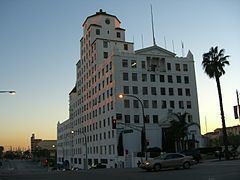Floor count 14 Floors 14 | Height 60 m Architecture firm Meyer & Holler | |
 | ||
Similar First National Bank of L, The Pike, Villa Riviera, Renaissance Long Beach Ho, Los Cerritos Ranch H | ||
110 w ocean blvd offices at ocean center building
The Ocean Center Building is a 14-story, 197-foot-tall office building in downtown Long Beach, California built in 1929 by architect Raymond M. Kennedy.
Contents
- 110 w ocean blvd offices at ocean center building
- Map of Ocean Center Building Long Beach CA 90802 USA
- References
Map of Ocean Center Building, Long Beach, CA 90802, USA
The Ocean Center Building has two ground floors, an entrance above the shoreline on the bluff level to take advantage of its address on 110 West Ocean Boulevard and an east entrance at the base of the Pine Avenue incline providing beach access and accommodating the Walk of a Thousand Lights of The Pike amusement zone . The building houses a collection of shops, offices and parking. At beach level there is a shopping arcade (architecture) archway key-stoned a restaurant (later converted to a penny arcade) and an immense menswear store (later converted to the Hollywood on the Pike cabaret,) and several small shops up the sidewalk incline of Pine St. There is a monthly rental parking space above the shops. The rest of the building is reserved for retail and office space. The office space above the lobby is divided by varying heights of the roof, allowing outdoor roof-top balcony space to select offices, turrets and a tower. The roofline is different when viewed from the east or west. Battlements along the different roof heights give the observer the impression of the building as being a castle.
Though originally built next to the shoreline, a number of geological and engineering changes have made it so today there is a long walk to seawater from the Ocean Center Building. When the Long Beach Harbor and breakwater were developed, and the Los Angeles River straightened and levied by the United States Army Corps of Engineers, the Pacific Ocean no longer swept the alluvial granite sand away and the deposits of sandy beach continued to widen. By the 1950s the sand of the beach had grown so wide that the space between the shoreline and the Ocean Center Building was paved as a parking lot and is now Seaside Way. Coastal landfill continued, the beach filled in, then Shoreline Drive and Shoreline Village were built upon the fill.
Ocean Center has made use of frontage which had originally been a boardwalk placed onto the sand easing access from Pine St. and the shore end of the Long Beach Pier to the bathhouse (1902), later named The Plunge. The low-tech boardwalk was originally known as The Pike, which later changed context to include the entire entertainment zone of rides, snack stands and midway games. The area has been featured in thousands of tourist photographs and several television shows and motion pictures, such as It's a Mad, Mad, Mad, Mad World. The boardwalk was paved in concrete and illuminated by strings of lights hung across it from the roofs of its shops and games, then was renamed The Walk of 1000 lights. The Ocean Center Building arcade presented the first impression to many visitors as a grand gateway to fun.
